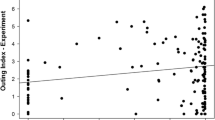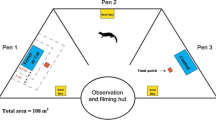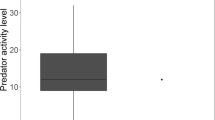Summary
When minnows (Phoxinus phoxinus) detect a stalking pike (Esox lucius) one of their first responses is to perform ‘inspection behaviour’ during which individuals or small groups approach the predator. This paper compares the inspection behaviour of two contrasting groups of minnows: Dorset minnows which have been heavily predated by pike for many thousands of years and Gwynedd minnows which have spent an equivalent period of time in a pike free environment. Minnows sympatric with pike inspected a realistic model pike more frequently and in larger shoals. Although they commenced inspection earlier they were more timid and kept a greater distance between themselves and the predator. After an inspection they were less likely to recommence foraging than minnows from the Gwynedd population. Individual differences in inspection found within the two populations suggest that selfish behaviour was present.
Similar content being viewed by others
References
Bertram BCR (1978) Living in groups: predators and prey. in: Krebs JR, Davies NB (eds) Behavioural ecology. Blackwell, Oxford, pp 64–96
Curio E (1978) The adaptive significance of avian mobbing. 1. teleonomic hypotheses and predictions. Z Tierpsychol 48:175–183
Dill LM (1974) The escape respone of the of the zebra danio (Brachydani rerio), II. the effect of experience. Anim Behav 22:723–730
Dominey WJ (1983) Mobbing in colonially nesting fishes, especially the blue-gill, Lepomis macrochirus. Copeia 4:1086–1088
Forrest HE (1907) The vertebrate fauna of North Wales, Witherby, London
George CJW (1960) Behavioral interaction of the pickerel (Esox niger and Esox americanus) and the mosquitofish (Gambusia patruelis). PhD thesis, Harvard University
Giles N (1984) Development of the overhead fright response in wild and predator-naive three-spined sticklebacks, Gasterosteus aculeatus L. Anim Behav 32:276–279
Hart PJB, Connellan B (1984) Cost of prey capture, growth rate and ration size in in pike Esox lucius L., as functions of prey wight. J Fish Biol 25:279–294
Huntingford FA (1976a) An investigation of the territorial behaviour of 3-spined sticklebacks using Principal Components Analysis. Anim Behav 24:822–834
Huntingford FA (1976b) A comparison of the reaction of stick-lebacks in different reproductive conditions towards conspecifics and predators. Anim Behav 24:694–697
Huntingford FA (1984) Some ethical issues raised by studies of predation and aggression. Anim Behav 32:210–215
Magurran AE, Girling S (1986) Predator recognition and response habituation in shoaling minnows. Anim Behav 34:510–518
Magurran AE, Oulton WJ, Pitcher TJ (1985) Vigilant behaviour and shoal size in minnows. Z Tierpsychol 67:167–178
Magurran AE, Pitcher TJ (1986) Provenance, shoal size and the organisation of predator evasion behaviour in minnows. Proc R Soc. London B 39 (in press)
Maitland PS (1972) A key to the freshwater fishes of the British Isles. Freshwater Biological Association, scientific publication No. 27, Windermere, England
Mann RHK (1982) The annual food consumption and prey preferences of pike (Esox lucius) in the River Frome, Dorset. J Anim Ecol 51:81–96
Maxwell H (1904) British fresh-water fishes. Hutchinson, London
Milinski M (1984) A predators cost of overcoming the confusion effect of swarming prey. Anim Behav 32:1157–1162
Motta PJ (1983) Response by potential prey to coral reef fish predators. Anim Behav 31:1257–1259
Neill SRStJ, Cullen JM (1974) Experiments on whether schooling by their prey affects the hunting behaviour of cephalopods and fish predators. J Zool (Lond) 172:549–569
Pitcher TJ (1980) Some ecological consequences of fish school volumes. Freshwater Biol 10:539–544
Pitcher TJ (1986) Functions of shoaling behaviour in teleosts. In: Pitcher TJ (ed) The behaviour of teleost fishes. Croom Helm, Beckenham Kent
Pitcher TJ, Kennedy GJA (1977) The longevity and quality of fin marks made with a jet innoculator. Fish Mgmt 8:16–18
Pitcher TJ, Green D, Magurran AE (1986) Dicing with death: predator inspection behaviour in minnows. J Fish Biol 28: 439–448
Seghers B (1974) Schooling behaviour in the guppy (Poecilia reticulata): an evolutionary response to predation. Evolution 28:486–489
Siegel S (1956) Nonparametric statistics for the behavioral sciences. McGraw-Hill, New York
Sokal RR, Rohlf FJ (1981) Biometry, Freeman, San Francisco
Varley ME (1967) British freshwater fishes. Buckland Foundation, London
Webb PW (1982) Avoidance responses of fathead minnows to strikes by four teleost predators. J Comp Physiol 147: 371–378
Webb PW (1984) Form and function in fish swimming. Sci Am 251:58–69
Author information
Authors and Affiliations
Rights and permissions
About this article
Cite this article
Magurran, A.E. Predator inspection behaviour in minnow shoals: differences between populations and individuals. Behav Ecol Sociobiol 19, 267–273 (1986). https://doi.org/10.1007/BF00300641
Received:
Accepted:
Issue Date:
DOI: https://doi.org/10.1007/BF00300641




